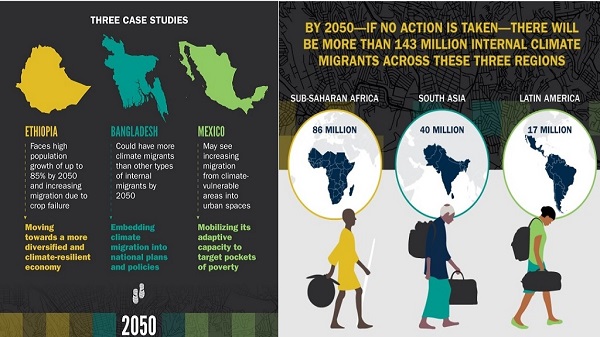
Sub-Saharan Africa, South Asia, and Latin America could be dealing with a combined total of over 140 million internal climate migrants by 2050.
(World Bank)–Humanity has always been on the move.
People move for many reasons – economic, social, and political. Now, climate change has emerged as a major driver of migration, propelling increasing numbers of people to move from vulnerable to more viable areas of their countries to build new lives.
The newly released World Bank report, Groundswell: Preparing for Internal Climate Migration, analyzes this recent phenomenon and projects forward to 2050. Focusing on three regions — Sub-Saharan Africa, South Asia, and Latin America – the report warns that unless urgent climate and development action is taken, these three regions could be dealing with a combined total of over 140 million internal climate migrants by 2050. These people will be pushed out by droughts, failing crops, rising sea levels, and storm surges.
But there is still a way out: with concerted action – including global efforts to cut greenhouse gas emissions, combined with robust development planning at the country level –the number of people forced to move due to climate change could be reduced by as much as 80 percent – or 100 million people.
Wolde Danse, a 28-year-old from Ethiopia, is also turning adversity into a chance to change the course of his life. The eighth of 16 children, he left his father’s small farm in a drought-stricken part of his country and moved to the city of Hawassa in search of new opportunities: “In the planting season, it wouldn’t rain, but when we didn’t want it, it would rain. This created drought, and because of this, I didn’t want to suffer anymore.” After some initial struggles, Wolde enrolled in Ethiopia’s extensive urban safety net program, and now he receives a small salary for supervising street cleaners. As part of the program, Wolde can attend Hawassa University without paying tuition, and he’s planning to finish his studies to benefit his country and his family.
Without concrete climate and development action, Sub-Saharan Africa could have 86 million internal climate migrants by 2050, with Ethiopia one of the most vulnerable countries to climate change in Africa, due to its reliance on rain-fed agriculture. Ethiopia’s population is likely to grow by 60-85 percent by 2050, placing additional pressure on the country’s natural resources and institutions. Ethiopia is taking steps to diversify its economy and prepare for increased internal migration.
Read the complete story at The World Bank
